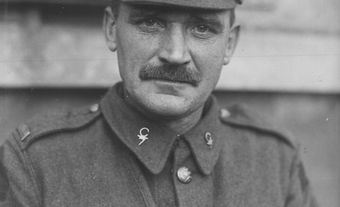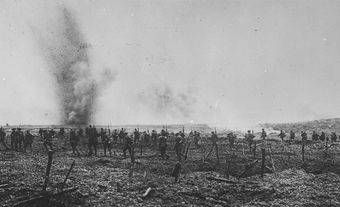On 1 July 1916, Allied forces launched a major offensive in France during the First World War. The opening of the Somme offensive turned into one of the deadliest days in the history of modern warfare. At the village of Beaumont-Hamel, the Newfoundland Regiment suffered catastrophic losses. More than 80 percent of the soldiers who advanced that day were either killed or wounded. In one morning, the regiment suffered approximately 700 casualties, including more than 300 dead.
Beaumont-Hamel: Key Facts
| Date | 1 July 1916
|
| Location | Beaumont-Hamel, France
|
| Participants |
Britain, British Commonwealth (including Newfoundland) Germany |
| Casualties |
57,470 British and Commonwealth casualties (19,240 dead)
|

Map of the Battle of the Somme, 1916, during the First World War.
(courtesy U.S. Army/Wikimedia CC)
Birth of a Regiment
When Great Britain declared war on Germany in August 1914, Newfoundland, then a British dominion, had no army, not even an army militia. But when the call went out to aid the empire, hundreds of young men volunteered as soldiers, and the Newfoundland Regiment was soon born. Uniforms were quickly assembled, and when they ran out of khaki, navy cloth was used to make puttees, or leggings, for the soldiers — who quickly became known as the Blue Puttees.
The first Newfoundland contingent of 537 soldiers and officers departed for Europe in October 1914, with more soldiers soon to follow.
Battle of the Somme
In the spring of 1916, after fighting in Gallipoli, Turkey, the Newfoundland Regiment was transferred to the Western Front in France to prepare for the offensive in the Somme valley. The Newfoundlanders were ordered to attack German lines at the village of Beaumont-Hamel, as part of the initial phase of the Battle of the Somme.
The Germans were deeply entrenched at Beaumont-Hamel. In the days leading up to the “Big Push” on the opening of the offensive, Allied commanders repeatedly bombarded the German lines with artillery — attacks they hoped would severely damage enemy fortifications. But at 7:30 a.m., on 1 July 1916, when the first wave of Allied soldiers went over the top of their trenches and into no man's land, the Germans were ready and waiting, having largely survived the artillery bombardment.
The battlefield at Beaumont-Hamel soon became littered with hundreds of dead and dying Allied soldiers. Yet, the commanders decided to press on. At 9:15 a.m. the Newfoundlanders were ordered to attack from their trench behind the front line, nicknamed St. John's Road. Weighed down by backpacks weighing almost 30 kg, they had to move across open ground in full view of German machine guns and artillery. The soldiers of the First Newfoundland Regiment were slaughtered in an attack lasting less than 30 minutes.
Private Anthony Stacey, who witnessed the carnage from a forward trench, later described men being mown down in waves: "The enemy just set the sights of the machine guns on the gaps in the barbed wire and fired." Stacey wrote that he "could see no moving, but heaps of khaki slumped on the ground."
Wounded soldiers tried to get back to their own lines throughout the day. But enemy snipers, machine gunners and artillery fire made this difficult and dangerous. Some of the wounded died where they lay; others were killed while trying to retreat.
Casualties
The losses were devastating. Of the approximately 800 soldiers of the Newfoundland Regiment who fought that day, only 68 were able to answer roll call following the battle. The regiment suffered 710 casualties — 386 wounded and 324 who were killed, died of their wounds, or missing (presumed dead).The dead included several sets of brothers.
In total, 19,240 British and Commonwealth soldiers died on 1 July 1916. More than 38,000 were wounded, for a total of 57,470 casualties. Approximately 8,000 German were killed or wounded.

Owen Steele was an officer in the Newfoundland Regiment and served during the First World War; he died in France in July 1916.
(courtesy The Rooms Archives and Museum/Veterans Affairs Canada)
Did you know?
Lieutenant Owen William Steele kept a detailed diary of his service with the Newfoundland Regiment. His diary and letters reflect the experience and impressions of Newfoundland soldiers during their training in the United Kingdom and service in the Gallipoli campaign and Battle of the Somme. Steele didn’t participate in the Battle of Beaumont-Hamel but was wounded by shrapnel on 7 July 1916 and died the following day. His brother, James R. Steele, also served with the regiment. He was seriously wounded during the Battle of Beaumont-Hamel but survived the war and returned to St. John’s, Newfoundland.
Aftermath
The first reports to reach Newfoundland spoke of a glorious victory. But in the weeks to follow, families throughout the colony began to learn the terrible truth. Hundreds of young men had been wiped out.
British General Aylmer Hunter-Weston offered his condolences to Newfoundland: "There were no waverers, no stragglers, not a man looked back," he wrote. "It was a magnificent display of trained and disciplined valour, and its assault only failed of success because dead men can advance no further."
Despite its staggering losses, the First Newfoundland Regiment regrouped with fresh troops from home, and would go on to fight in several important battles of the war, at Guedecourt, Ypres, Arras, Courtrai and Cambrai.
In 1917, after the battles at Cambrai and Ypres, the British Crown awarded the regiment the designation of “Royal” — the only regiment to earn that honour during the First World War.
By the time the armistice was signed in 1918, 6,241 men had served in the Royal Newfoundland Regiment. Of those, 1,304 — more than one in five — were killed. Hundreds more returned home severely injured. The loss of a generation of young men and leaders had a profound impact on Newfoundland's economic and cultural development.
I guess everyone had someone they knew who fought or died there. The story of Beaumont-Hamel is to Newfoundland what Gallipoli is to the Australians. (Stories of Remembrance: Mary Walsh)
Remembrance
Newfoundland did not forget the sacrifices of its young men at Beaumont-Hamel. The first Memorial Day was organized in St. John's on 1 July 1917. A year later, legislation officially established 1 July as Memorial Day, Newfoundland's official day of remembrance.
At Beaumont-Hamel, the battlefield is now a park. At its highest point a statue of a caribou, the official emblem of the Royal Newfoundland Regiment, looks out over the field where so many died. Their names fill three brass plaques at the base of the monument.

 Share on Facebook
Share on Facebook Share on X
Share on X Share by Email
Share by Email Share on Google Classroom
Share on Google Classroom












